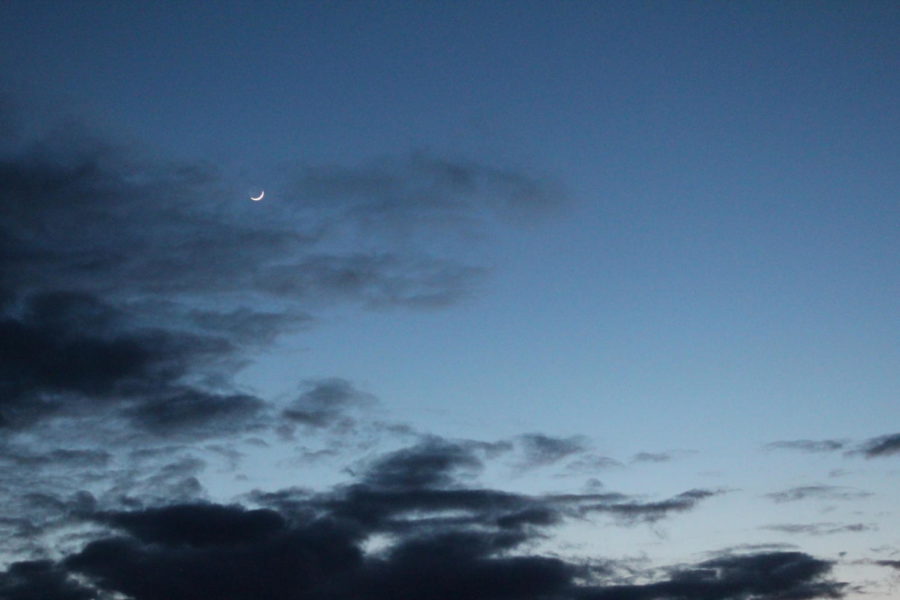2021 Stargazing Events (April-July)
Photo by Brookelyn Evans
April night’s sky just after sun set, the moon in its Waxing Crescent phase.
Do you ever look up at the sky at night and happen to catch a glimpse of all the stars and galaxies? It’s a sight that just seems to take your breath away no matter where you are. You think to yourself how crazy it is that we are so tiny and the stars are light-years away. How the moon can light up the dark night and how it all revolves around the North Star. If you are as entranced by the night sky as I am, then this story is for you.
The year ahead holds many spectacular astronomical views you won’t want to miss. Despite all the ups and downs of our lives right now, we can look ahead to these amazing moments in time that we have the incredible ability to see.
Earthshine Nights:
Pay close attention to the moon in April and May, the waxing and waning crescent moon phases are going to be the best time to see “Earthshine”, where the unlit portion of the moon becomes visible to the human eye.
April 22/23: Lyrid Meteor Shower
This meteor shower is set to begin by April 15 but is projected to peak the evening of April 21 and into the morning hours of April 22. The Lyrids are one of the oldest known Meteor Showers with the first recorded sighting dating back to 687 BC. During peak activity hours up to 20 meteors can be seen per hour. The Lyrid meteors shine near the bright star Vega in the constellation Lyra the Harp, but you don’t necessarily need to identify that constellation to be able to see the meteor shower because they will appear unexpectedly in any part of the sky.
April 26/27: Super Moon/Pink Moon:
Throughout North America later this April, a full moon will appear, you’re probably thinking that’s no big deal because there is a full moon every month. But this one is special, it’s a Pink Moon, and this year it is also going to be a Super Moon, where the moon will seem a little larger than a regular full moon. Unfortunately, the moon does not actually turn pink for a night, the color shift comes from position and viewpoint. This event has also been referred to as the Full Sprouting Grass Moon because it occurs around the time that the new spring grass will start to grow. A Super Moon happens when the full moon corresponds with the moon’s closest approach to Earth in its orbit making it seem larger.
May 5th: Eta Aquariids Meteor Shower
You may be thinking this is just another meteor shower but the Eta Aquariids is actually kind of cool. This shower is associated with Halley’s Comet and is one of two from her comet. The sister shower, the Orionids, won’t peak until October. Another factor that makes this shower unique, the meteors will streak through the sky at speeds up to 148,000 miles per hour making it one of the fastest meteor showers.
May 26th: “Blood moon” Total Lunar Eclipse
In the early morning hours of Wednesday, May 26 Across the Western U.S. a total lunar eclipse will occur. Totality will be visible around 5:00-6:00 am central time. This will be the first Lunar eclipse since January 2019. A lunar eclipse occurs when the moon moves into Earth’s shadow, this happens only when the Earth, sun, and moon all align in space. It is noted in this National Geographics article that, “During the total part of the eclipse, sunlight shining through the ring of Earth’s dusty atmosphere is bent, or refracted, toward the red part of the spectrum and cast onto the moon’s surface. As a result, the moon will transform from a dark gray color during the partial phase of the eclipse to a reddish-orange color during totality. The moon’s exact color can vary depending on the amount of dust in Earth’s atmosphere.” If you’re not a morning person, make an exception for May 26 because you’re not gonna wanna miss this.
July 12: Venus-Mars Conjunction
Just like the Jupiter and Mars conjunction in December 2020, these planets will be so close it appears they are touching. Just after sunset on July 12 is when you’ll be able to look up and see this take place.
July 28: Delta Aquariids Meteor Shower
Another dazzling meteor shower taking place this year is the Delta Aquariids. Peaking in late July of this year the Delta Aquariids shower will be most visible in the Southern Hemisphere. According to this article, a good way to view a meteor shower like this one is to simply lie flat on your back and look up. Try to take in as much of the sky as you can, this will give you the best chance possible of seeing the meteors.
These, along with many shiny full moons and visible constellations, are all of the special events happening in the sky in the first months of the coming year. If you want to find out what magical night sky moments are coming later in the year, keep your eye out for part two of this story.







